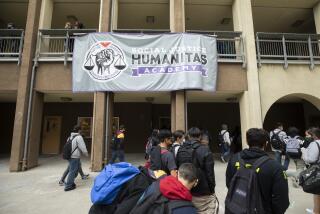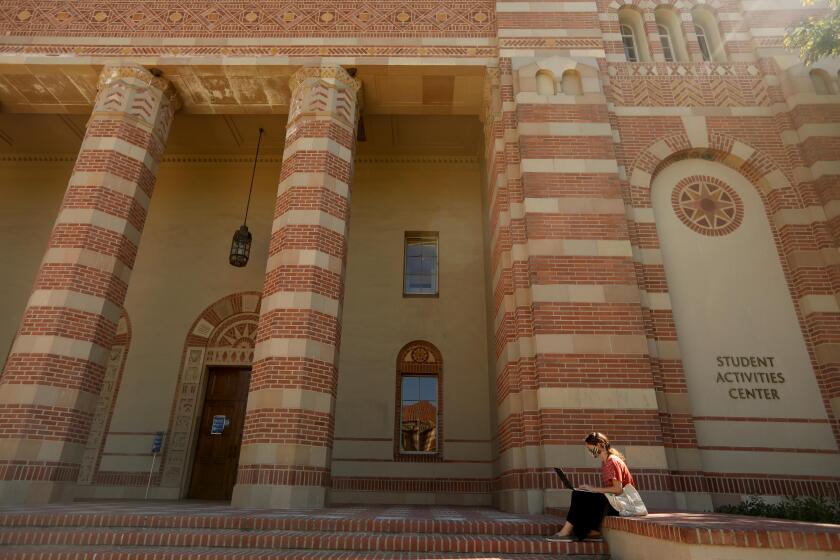A Look at What’s Really There in the CLAS Tests : Education: Provocative readings are included, as critics claim, but rumors have distorted the content.
- Share via
Open the closely guarded 1994 California Learning Assessment System test and here’s some of what you find:
“Do you think that people today are as strong as their parents and grandparents were?” the state asks fourth-graders. To eighth-graders: “Why do you think some teen-agers and their parents have problems communicating?”
And for 10th-graders: “Why do you think people can seem to be shy in one setting and outgoing in another? . . . Why is it that some people appear unable to talk at all?”
These are just three of hundreds of questions, tasks and instructions contained in the language arts portion of the state’s new student performance test, widely praised by educators but also under attack as too personal, too political and too vague to gauge student achievement.
The tests have not been released to the public, but copies obtained by The Times show much of what critics suspected: provocative readings about race, poverty and family relationships coupled with repeated requests for children’s opinions and reflections on personal experiences.
But the exams also show that the rumors have often exaggerated and distorted the content, focusing on the most sensitive passages and ignoring the context in which issues are discussed.
“We’re starting to hear things that parents say their kids say are on the test where that just isn’t the case,” state Department of Education spokeswoman Jan Agee said recently. “They’re reacting to rumors.”
Radically different in style from older standardized tests, the new assessment system seeks to gauge what students know through a variety of methods, from doodling exercises and group discussions to essays that require students to connect literary themes to their lives.
On various versions of the tests, students are prompted to display their writing skills by discussing when they did or said something they now regret, dreaming up a list of television programs, or describing someone who does not go along with the crowd.
More than 1 million children in 7,500 schools took CLAS this spring, amid a chorus of criticism from conservative Christian groups and some school boards, educators and parents. Opponents contend that CLAS is too subjective and that the language arts segments violate state law by questioning children about morality without parental permission. Courts have rejected the privacy argument.
State education officials and supporters in industry and academia insist that the tests are necessary to revive public education in California and that they will improve schools. The pointed questions gauge analytical thinking and prompt students to write passionately, officials say.
The state Department of Education has refused parent requests to view the tests, arguing that statewide tests are always kept confidential to protect the integrity of the exams. Now that testing has been completed for the year, state officials plan to release portions next month to public libraries.
Fourth-, eighth-, and 10th-graders take tests in language arts and math, and fifth-graders take exams in science and history/social science. It is the language arts section that is the most controversial.
Readings include stories about California youth by prominent authors--including Maxine Hong Kingston and Dick Gregory--plus classics such as an Aesop fable, a poem by John Updike, and a piece from Richard Wright’s book “Black Boy.” The works often deal with difficult themes: discrimination, fear, dreams, homelessness, hunger, dysfunctional families, religion, crime and death.
Tests are graded by specially hired and trained teachers who are supposed to evaluate the reading and writing skills of the students.
Here is a closer look at the language arts exams given to each grade.
10TH GRADE
Each student reads one of these selections: Kingston’s memoir of her childhood as a Chinese immigrant, a story about a son’s changing image of his father, one boy’s recollection of his friendship with his Spanish-speaking great-grandmother, or a pair of poems about heroic athletes.
In an excerpt from “The Woman Warrior: Memoirs of a Girlhood Among Ghosts,” Kingston recalls her mother slicing underneath her tongue--”so that you would not be tongue-tied.” Later, the students are asked whether they believe Kingston’s tongue was ever actually cut. The writing assignment asks why children “feel unable to speak or to have nothing to say.” Swedish author Par Lagerkvist’s “Father and I” chronicles a walk along railroad tracks. The boy in the story becomes frightened as night falls, and his father soothes him by reminding him of God. But the boy quivers, convinced that God “too was horrible.”
Some students are asked to write essays interpreting the relationship between father and son, while others are told to describe an incident “from which you learned something important about yourself.”
A third reading for 10th-graders is “The Horned Toad,” by Gerald Haslam, which opens with a bilingual conversation among members of a California family. In the reading, a Spanish-speaking woman chastises her great-grandson for removing a toad from its home. When the old lady dies, the boy remembers this lesson, and insists that she be buried where she had lived.
In response, students are asked to write an essay titled “The Relationship Between Where We Live and Who We Are.”
“You do not have to convince your readers that your ideas are right,” the directions note. “Instead, you are sharing your thoughts, trying them out in an exploratory way.”
EIGHTH GRADE
All students read three nonfiction passages (about Louis Pasteur, polar bears and Dorothea Dix) and answer multiple-choice questions requiring close reading. They also must write a letter to help an aunt and uncle dress as “typical teen-agers” for a costume party.
The source of the most controversy over the tests is a segment in which eighth-graders use one of six coming-of-age stories, most of which deal with ethnicity.
Gregory’s “Not Poor, Just Broke” tells of a fatherless black second-grader trying to impress a girl with a big donation to the charity pot--only to be shamed when his teacher points out that he receives money from the pot.
In “Looking for Work,” Gary Soto revisits a poor, Latino 9-year-old desperate to live like Beaver Cleaver’s TV family. Morley Callaghan writes of a mother’s disappointment in her son, who steals from the drugstore where he works, in “All the Years of Her Life.” And “What I Want to be When I Grow Up,” by Martha Brooks, chronicles bus rides to the orthodontist by a sarcastic, judgmental teen-ager.
The two selections that have raised the most ire from critics are “Black Boy” and Marta Salinas’ “The Scholarship Jacket.”
The excerpt from Richard Wright’s award-winning novel opens with a stark passage about a child’s severe hunger. Wright’s mother sends him to the store for food, but a gang beats him up and steals his money. She sends him back into the street with a stick, instructing him not to return until he has the groceries.
Students read “Black Boy” along with the Stephen Spender poem “My Parents,” then are instructed to “write an essay . . . speculating about the reasons some parents try too hard to protect their children from the outside world.”
Salinas’ autobiographical story shows her as a poor Latina eighth-grader who is first in her class, eager to win the valedictorian’s jacket. The girl--called Martha at school and Marta at home--overhears two teachers talking about giving the jacket to the second-place student, a white girl whose father is on the school board.
Then the principal tells Martha that the scholarship jacket will cost $15. Her grandfather refuses to pay, saying a scholarship jacket should not be bought. Ultimately, Martha does win the jacket free.
In response to the story, students fill in a chart of “problems at school,” then write an essay “about a person you listen to and respect.”
FOURTH GRADE
For elementary-school students, the print on the exam booklets is larger, but the themes are similar. Students will be given one of seven different sets of reading material, including poetry, a biographical sketch of Rosa Parks, folk tales, and short stories.
Two stories by Cynthia Rylant show the tragedy of homelessness, and are followed by group and writing exercises about loneliness.
“Angel Child, Dragon Child,” by Michele Maria Surat, depicts a Vietnamese girl who is shunned at school for not speaking English, but eventually makes a friend who helps her raise money to bring her mother to America. Students are asked to write a booklet giving advice to new students at school.
Author Tomie dePaola’s “Now One Foot, Then the Other” tells a touching tale of a grandfather who teaches a little boy to walk, then has a stroke. The boy--named for the old man--then teaches the grandfather to walk.
“Pretend your school is giving a ‘Helping Hand Award,’ ” the test instructs. “Write about a time when you helped someone else.”
In “Fireflies!” a girl runs outside to catch the lightning bugs she sees out her window, then notices them struggling inside her jar and sets them free. After reading Julie Brinckloe’s story, students draw pictures of what they see out a window at home, and “what you might see if you looked out (a) wishing window into the world as you wish it to be.”
On one exam, there are two folk tales about loneliness. Students must create a conversation between animal characters in the two tales, then “write about what it is like to be by yourself.”
Similar selections are on a second test, with Leo Lionni’s “Frederick” and Aesop’s fable “The Grasshopper and the Ant.”
Finally, there is an account of Parks and the Montgomery, Ala., bus boycott, paired with a Margaret Walker poem about black female ancestry.
“Think about a rule at your school--on the playground, in the cafeteria, or in the classroom--that you think needs to be changed,” the test instructs, picking up on the protest theme. “Write a letter to the principal about a school rule you want changed.”
More to Read
Sign up for Essential California
The most important California stories and recommendations in your inbox every morning.
You may occasionally receive promotional content from the Los Angeles Times.










